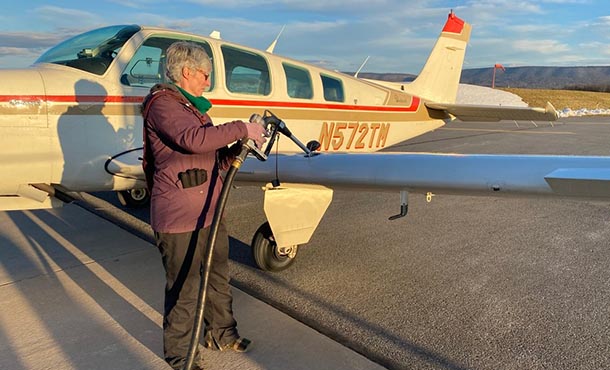
Amy Pritchett, professor and head of aerospace engineering at Penn State, fuels a Beechcraft Bonanza at the University Park Airport near Mount Nittany. The single piston engine aircraft is similar to many that perform critical societal functions and requires leaded fuel. IMAGE: AMY PRITCHETT/PENN STATE
Report calls for multipronged action to mitigate small aircraft lead emissions
Amy Pritchett, head of aerospace engineering, led the National Academies study
1/15/2021
By Ashley J. WennersHerron
UNIVERSITY PARK, Pa. — The National Academies of Sciences, Engineering, and Medicine released on Jan. 12 a congressionally mandated report on reducing lead emissions from small aircraft — the single largest lead emitter in the United States. The report summarizes a study chaired by Amy Pritchett, professor and head of aerospace engineering in Penn State’s College of Engineering, involving experts both in aviation fuels and technology and in lead emissions and effects on human health.
The committee recommends a widescale, multipronged educational approach to reduce lead emissions and exposure across the more than 13,000 airports and countless remote communities in the United States that depend on small aircraft for pilot training, aerial firefighting, medical airlifts and more.
“It’s critical to address how to reduce lead emissions,” Pritchett said, noting the myriad health problems lead can induce. “Lead is a persistent pollutant. Once it is emitted into the environment from the aircraft, it sinks to the soil and stays there. It doesn’t degrade.”
The addition of ethanol to automobile gasoline eliminated the need for leaded gas in cars, and large jets run on a form of kerosene that does not require lead. Small, piston engine aircraft with propellers run on fuel containing tetraethyl lead (TEL), a form of lead that allows for the high octane burst of power to move the engine.
“These aircraft engines, which must operate over a wide range of altitudes, work differently than automobiles and require a higher octane that, right now, only TEL can provide,” Pritchett said. “You don’t want your engine stalling out midflight, especially if you only have one engine. Only fuel that has TEL works in these conditions.”
Even if there were an unleaded fuel that could propel these aircraft, changing the fuel could require changing both the aircraft systems and the fuel supply chain, according to Pritchett.
“Most small airports are owned by municipalities or small private organizations,” Pritchett said. “These are not large, money-making ventures that could afford $100,000 or more to retrofit a single airport to set up a new fueling system.”
Without a viable short-term technical solution to eliminate lead emissions, the committee recommends that the Federal Aviation Administration work with other federal agencies, such as the U.S. Environmental Protection Agency and Occupational Safety and Health Administration, and the entire aviation industry spanning the roughly 170,000 privately owned aircraft that currently rely on leaded fuel.
“Every stakeholder, from government agencies to individuals, should be educated, trained and generally made aware of the lead hazards and available mitigation measures, especially for pilots, airport personnel and aircraft technicians,” Pritchett said.
In parallel with the educational efforts, the committee recommended continued scientific pursuit of new technologies, including lead-free propulsion systems such as electric or hydrogen-powered aircraft. The transition to next-generation small aircraft may require congressional initiatives, according to the report, such as policy requiring all new aircraft produced 10 years from now to run on unleaded fuel.
“There are no simple solutions here,” Pritchett said. “We need widespread, broad, private-public contributions and collaborations to find unleaded solutions that will work for small aircraft and the people they serve.”
About the National Academies
The National Academies are private, nonprofit institutions that provide independent, objective analysis and advice to the nation to solve complex problems and inform public policy decisions related to science, technology and medicine. The academies operate under an 1863 congressional charter to the National Academy of Sciences, signed by then-President Abraham Lincoln.



